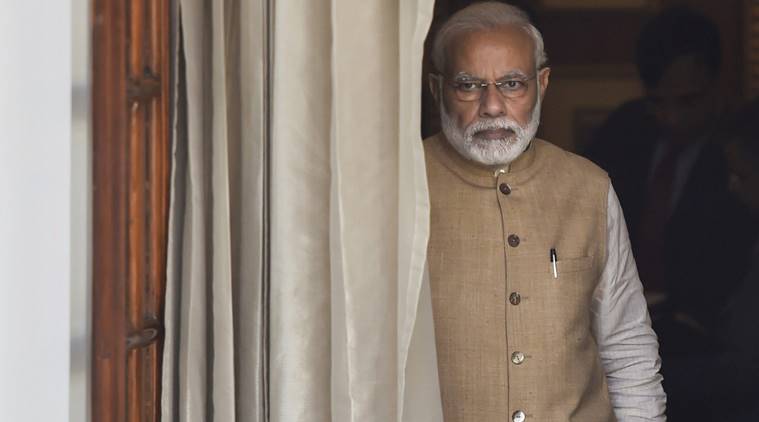Feet of clay
How top-down decision-making, delusions of grandeur led a strong government to poor decisions

Prime Minister Narendra Modi in New Delhi. (Source: PTI Photo/Atul Yadav/File)
Strong leaders heading majority governments are an asset to most of us. They are decisive; their political capital allows them to practise tough love and not be swayed by short-term populism.
But strong leaders can also be a liability when they develop delusions of grandeur, or are surrounded by people who only give achchi khabar (positive feedback) and are afraid to say, “Sir, I beg to disagree”.
Narendra Modi’s government can be credited with doing at least two right things at the very start of its tenure.
The first one was raising excise duties on petrol and diesel, and not completely passing on the benefits of lower international oil prices — the average cost of crude imported by Indian refiners fell from $105.52 per barrel during 2013-14 to $84.16, $46.17 and $47.56 in the following three years — to consumers. This made sense, both from the standpoint of fiscal consolidation and discouraging overconsumption of a high import-bill commodity.
The first one was raising excise duties on petrol and diesel, and not completely passing on the benefits of lower international oil prices — the average cost of crude imported by Indian refiners fell from $105.52 per barrel during 2013-14 to $84.16, $46.17 and $47.56 in the following three years — to consumers. This made sense, both from the standpoint of fiscal consolidation and discouraging overconsumption of a high import-bill commodity.
The second sound decision was the signing of the Monetary Policy Framework Agreement between the finance ministry and the Reserve Bank of India (RBI) on February 20, 2015. The agreement fixed responsibility on the central bank to achieve a 4 per cent (+/-2 per cent) consumer price inflation target by 2016-17. While it may have prompted undesirable export restrictions and so-called anti-hoarding measures on agricultural commodities, making inflation targeting an explicit policy goal was, nevertheless, a significant move that reinforced the government’s commitment to macroeconomic stability.
But far outweighing these “good” are the many bad or, for that matter, even good things not done at the right time by this government. The fault here lies with not seeking honest professional opinion and, instead, being guided by ideologues and officials who aren’t disposed to saying anything their masters don’t want to know or hear.
Let’s first take the latter — the good things that ought to have been done at the very outset.
Let’s first take the latter — the good things that ought to have been done at the very outset.
On December 19, 2014, the Finance Ministry’s Mid-Year Economic Analysis flagged what the Chief Economic Adviser Arvind Subramanian was to term as the Twin Balance Sheet (TBS) problem — of corporates that had accumulated too much debt in taking up projects during the 2004-2011 investment boom, and public sector banks (PSB) that had extended the bulk of these loans. When the projects got grounded or did not generate the anticipated cash flows, the unserviceable debts on the liabilities side of corporate balance sheets turned into “non-performing assets” of PSBs.
The Modi government, initially, seemed alive to the problem. In April 2015, the RBI launched an Asset Quality Review inspection of banks, forcing them to recognise the true extent of bad loans and make provisions for these in their books fully by March 2017. In August 2015, the finance ministry announced budget support of Rs 70,000 crore as part of a four-year Rs 1,80,000-crore Indradhanush Plan for recapitalisation of PSBs to enable them to absorb loan losses. In May 2016, Parliament enacted the Insolvency and Bankruptcy Code, empowering banks to take corporate defaulters to a special court and initiate a time-bound process of recovery via “resolution” (sale of underlying assets to new promoters/investors) or outright liquidation.
Everything appeared to be going right till this point. The revenue windfall from oil afforded enough fiscal headroom for infusion of fresh capital into PSBs. Low interest rates globally, coupled with macroeconomic and political stability back home, had renewed foreign investors’ faith in India after the turbulent last years of the UPA regime — marked by double-digit inflation, a rupee in free fall and high fiscal-cum-current account deficits. And with growth, too, recovering — from 5.4 per cent in 2012-13 and 6.1 per cent in 2013-14 to 7.2 per cent and 8.1 per cent in 2014-15 and 2015-2016 — conditions couldn’t have been more opportune for fixing the TBS problem. Resolutions and liquidations may have entailed job losses, but a growing economy would well have absorbed all this pain. And the pain was worth bearing if we had recapitalised and reformed PSBs, with fully cleaned-up balance sheets, at the end of it.
Sadly, that Goldilocks opportunity was squandered with the overnight invalidation of banknotes accounting for nearly 86 per cent of the total currency in circulation on November 8, 2016. It was a decision no professional economist with spine would have endorsed — in a country facing no runaway inflation or a run on its currency. Among the other things demonetisation did was to divert the focus of banks and the RBI away from the TBS challenge — the stressed advances ratio of PSBs touched 15.6 per cent by March 2017 — to facilitating the deposit and exchange of the scrapped notes and remonetisation of the economy. In July 2017 came a fresh shock: Goods and Services Tax (GST).
In GST, the flaw wasn’t in the idea per se, but in the sheer unpreparedness of implementation. The whole system of filing returns — providing details of both outward and inward supply of goods, along with the matching of invoices uploaded at the supplier and recipient ends — failed to work: The GST’s IT network just couldn’t handle the enormous data traffic. At the same time, it increased the compliance burden on small businesses, including exporters; they were previously exempted from paying any duties upfront, but now had to first cough up tax and suffer delays in claiming refunds later.
Both demonetisation and GST inflicted greatest harm on MSMEs, farmers and petty producers, who hadn’t caused the TBS crisis in the first place. Meanwhile, as the dual disruptions led to growth slowing down to 7.1 per cent in 2016-17 and 6.5 per cent in 2017-18, corporate defaults and the banking sector’s woes only multiplied. The seeds of the TBS problem may have been sown during the UPA years, but there has been a clear cost to not addressing what the Modi government’s chief economic adviser had, in late-2014, recognised as the biggest source of macro instability and deterrent to an investment pick-up.
Whether it is demonetisation, GST or banning sale of cattle for slaughter in livestock markets, one can discern a pattern to the working of this government: Obsession with creating history while ignoring more mundane but festering issues; top-down decision-making sans any real consultation or thinking through the consequences; and implementation left to officials having neither the domain expertise nor direct stakes in the affected sectors.
The last one year has, unfortunately, seen the earlier Goldilocks moment give way to a perfect storm of rising oil prices, renewed capital outflows from emerging markets, and the end of an almost decade-long party of ultra-low global interest rates. The “twin deficits” are also back, even as the TBS problem remains unresolved and the turning of the interest rate cycle, along with a weakening rupee, threatens to make it worse. It’s in times like these that even the strongest leaders with the loftiest of visions and noblest of intentions are found to have feet of clay.
harish.damodaran@expressindia.com
For all the latest Opinion News, download Indian Express App
More From Harish Damodaran
- The economics of long-run growth, in tech innovation and climate changeSveriges Riksbank Prize in Economic Sciences in memory of Alfred Nobel: The two men awarded have been obsessed with economic growth and human welfare outcomes…
- What new Rabi MSPs don’t factor in: Actual price hikes for diesel, other inputsFor the upcoming 2018-19 rabi planting season, the Commission for Agricultural Costs and Prices (CACP) in the Agriculture Ministry has computed the all-India average A2+FL…
- Eye on state polls, ear to protests, government hikes MSPs for rabi cropsThe latest MSP hike takes the total increase during the current NDA government’s tenure from 2014-15 to 2018-19 to Rs 440 per quintal for wheat…







































No hay comentarios:
Publicar un comentario